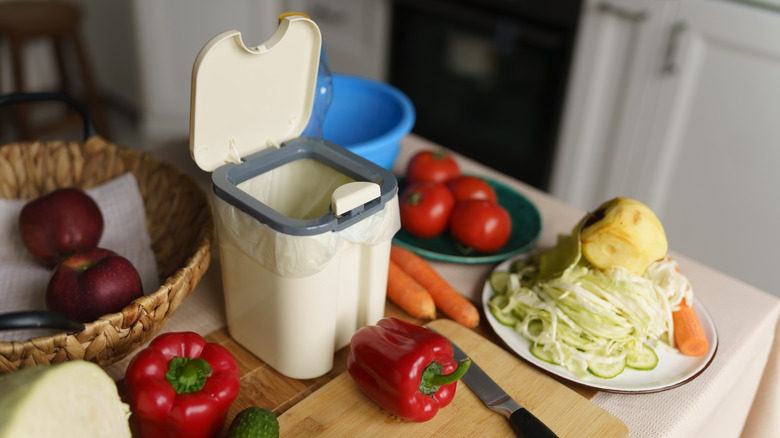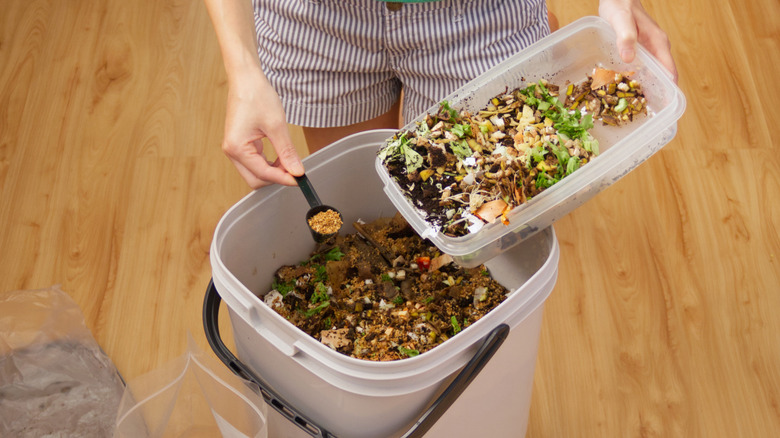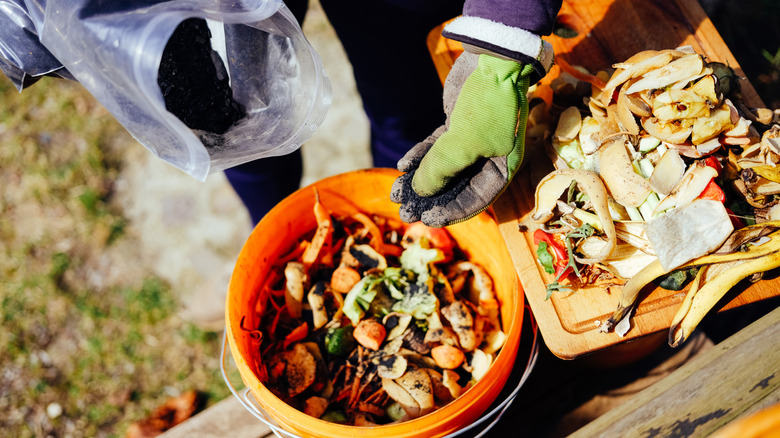Short On Outdoor Space? Bokashi Composting Might Be Perfect For You
We may receive a commission on purchases made from links.
Composting at home has many benefits, from enriching the soil with nutrients to reducing methane emissions by diverting food waste from landfills. People typically compost fruit peels, vegetable scraps, and coffee grounds outside where air can easily move through these materials. This helps them break down properly and minimizes unpleasant smells. Figuring out how to compost if you don't have much outdoor space can be tricky. A well-designed indoor compost bin is one solution. Some indoor bins use vermicomposting, a worm-fueled method of turning produce scraps into a garden additive that improves soil structure. Not everyone is ready to welcome worms into their home though. Bokashi composting is a worm-free alternative that doesn't have to take up much space.
This technique uses fermentation to transform leftover food into a nutrient-packed soil amendment. After the materials in a Bokashi composter ferment, they produce a substance called pre-compost. It can't function as mulch like traditional compost can, but it supercharges your garden soil if you add it to holes or trenches that don't have direct contact with your plants. More immediately, you can use the liquid by-product the composter makes by mixing it with water. This style of composting has roots in Asia, where fermentation has long been a component of farming and household waste management. In the 1980s, a Japanese professor named Teruo Higa adapted the process to incorporate findings from his research on agricultural microorganisms. Bokashi simply means "fermented organic matter." Understanding how fermentation works can help you master this method in no time.
How Bokashi composting works
Most outdoor compost bins are powered by aerobic bacteria and fungi, which need air to thrive. Many experts recommend turning outdoor compost heaps frequently to deliver air to the microorganisms in the middle. However, Bokashi composting relies on anaerobic bacteria, which don't need air and often emit a rotten-egg scent when exposed to it. Oxygen can slow down the fermentation process too, so look for a bin with an airtight lid if you're going to try this method. You'll also need to tamp down the material in the bin to force oxygen out, but you'll never have to turn a pile of decomposing matter with a pitchfork.
Bokashi bran — a blend of lactic acid bacteria, soil-friendly yeast, and a mix of fibrous materials for the microbes to eat, such as wheat bran, rice husks, or soybean hulls — also prevents foul smells while aiding the breakdown process. Amazon carries the popular TeraGanix EM Bokashi Bran Compost Starter. To mobilize these beneficial bacteria and yeasts, put Bokashi bran on your food scraps when depositing them in the bin. You'll also need to drain the liquid the fermenting pile creates. A Bokashi bin with a spigot — for instance, the Maze 14-liter Bokashi Kitchen Compost Bin — makes this easy. Want a bigger bin? Try the SCD Probiotics 5-gallon Composter Bucket that comes with a spigot and strainer.
Benefits of Bokashi composting
In addition to making indoor composting simpler, Bokashi bins are convenient since you can keep them in the kitchen. Plus, Bokashi bins can handle meat, dairy, bones, and a variety of cooked foods, which normally can't be composted outdoors because they tend to draw pests to the pile. Bokashi composters are exceptionally fast as well. They can turn your food scraps into pre-compost in two weeks, whereas outdoor aerobic composters often take months to do their job.
Bokashi compost bins are also eco-friendly. Like most composters, they keep plant-sustaining nutrients from going to waste, and thanks to fermentation, they do it in a way that releases little carbon dioxide and methane. Their decomposition process emits way less of these greenhouse gases than a landfill and lower levels than conventional composters do when they aren't properly aerated.
Another benefit of Bokashi composting is the liquid it produces. Sometimes called Bokashi tea, it makes a good fertilizer, especially for plants that appreciate acidic soil. Just combine 10 milliliters with 2 liters of water and pour some on the soil surrounding your plants' roots, not their stems and leaves. It's best to use Bokashi tea as soon as possible, but if you want it to last a few days, mix in a spoonful of molasses to feed the microorganisms and refrigerate it promptly. Don't need fertilizer? Use Bokashi tea to help clear out pipes, make outdoor composters more efficient, or combat odors in animal pens.
Getting started and troubleshooting
Using plenty of microbe-enriched bran is the key to successful Bokashi composting. Mix Bokashi bran with whatever food scraps you have on hand as you deposit it in the bin. Another approach is to sprinkle a layer of bran atop every inch or two of the pile. Whichever way you choose, aim for a tablespoon of bran per cup of food. Add a little more when inserting bones, noodles, and other items that take a while to decompose. Also, cut up big chunks so they ferment efficiently. Compress the pile with a potato masher every day, and remove its liquid every couple of days. When the bin runs out of space, seal it shut and let its contents marinate for 10 to 15 days before adding them to your garden. Then clean the bin.
There are a few items you shouldn't put in your Bokashi bin. Avoid moldy items and packaging materials. This includes most paper, but tissue is okay. Though pouring Coke on your outdoor compost heap is a hack worth trying, don't add soda, juice, or other liquids to your composter. Too much moisture encourages the pile to rot rather than ferment. If the pile's getting too wet, let your food scraps dry out before tossing them in. It's normal for the fermentation process to produce a pickle-like scent, but it shouldn't smell foul. Blue or black fungus is another sign that something has gone awry. If problems like these arise, check the bin's seal and try using more Bokashi bran.



